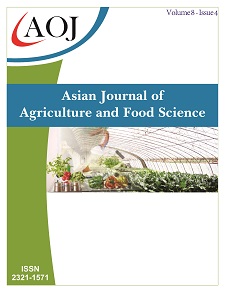Climate-Smart Initiatives in Sri Lankan Agriculture Sector: Experience and Perspectives in Solar Powered Water Pumping for Sustainable Crop Production
DOI:
https://doi.org/10.24203/ajafs.v8i4.6268Keywords:
water pumping; solar energy; diesel fuel; economic and environmental feasibilityAbstract
The availability of low cost and long-lasting water pumping technology is a dream of every farmer. In Sri Lanka, fuel or electricity-powered water pumps are used to irrigate thousands of hectares of field crops, Vegetables, and fruits. Based on the International Water Management Institute (IWMI) survey conducted in the year 2000, there are about 50,000 agro-wells in the dry zone of Sri Lanka. More than 110,000 pumps are used to pump water from those wells. The fuel cost is the biggest burden for the farmers, which results in a high cost of production. The use of solar energy for water pumping is a promising alternative to conventional electricity and fuel-based water pumping systems. Solar-powered water pumping is based on photovoltaic (PV) technology that converts solar energy into electrical energy to run a DC or AC type water pump. This paper presents a comparative analysis of economic and environmental benefits associated with solar water pumping systems against fuel-based water pumping systems. The analyses were based on practical experience over 50 acres of land cultivated for export-oriented Green Cucumber by 100 members of Tempitiya Farmer Organization in Ampara District of Sri Lanka. It concluded that the solar water pumping system is advantageous compared to a fuel-based pump in terms of economic and environmental aspects.
References
Abu-Nowar L.M., 2020. Economic and Financial Assessment of Solar-Powered Irrigation. Journal of Agricultural Science, 12(4), p.185. Available at: http://www.ccsenet.org/journal/index.php/jas/article/view/0/42217.
Aheeyar M., Bandara M.A.C.S., & Padmajani, 2012. Assessment of Solar Powered Drip Irrigation Project Implemented by Ministry of Agriculture - Phase 1. 10.13140-2.1.4766.0167.
Alireza R., & Gholamian S.A., 2013. Technical and Financial Analysis of Photovoltaic Water Pumping System for GORGAN, IRAN, International Journal on Cybernetics & Informatics (IJCI) Vol.2, No.2, April 2013. Retrieved from https://www.idc online.com/technical references/pdfs/information _technology/Technical%20and%20Financial.pdf
Campana Pietro Elia., Alexander Olsson., Hailong Li & Jinyue Yan.,2016. An economic analysis of photovoltaic water pumping irrigation systems, International Journal of Green Energy, 13:8, 831-839
Ceylon Electricity Board.,2013. Long Term Generation Expansion Plan 2015-2034, CEB – Sri Lanka, http://www.ceb.lk/index.php?aam_media=4464
Food and Agriculture Organization of the United Nations., 2011. Save and Grow: A Policy Maker’s Guide to the Sustainable Intensification of Smallholder Crop Production. FAO, Rome, Italy.
Horrigan., Lee., Robert S., Lawrence., & Polly Walker., 2002. How Sustainable Agriculture Can Address the Environmental and Human Health Harms of Industrial Agriculture. Environmental Health Perspectives. 110:5(May): 445-456.
Hossain M.A., Hassan., M.S., Mottalib M.A., & et al. 2015. Int J Energy Environ Eng 6: 147. https://doi.org/10.1007/s40095-015-0162-4
Intergovernmental Panel on Climate Change (IPCC).,2006. Guidelines for National Greenhouse Gas Inventories, http://www.ipcc-nggip.iges.or.jp/public/2006gl/vol2.html
IPCC SAR WG1.,1996. Houghton, J.T.; Meira Filho, L.G.; Callander, B.A.; Harris, N.; Kattenberg, A., and Maskell, K. (ed.), Climate Change 1995: The Science of Climate Change, Contribution of Working Group I to the Second Assessment Report of the Intergovernmental Panel on Climate Change, Cambridge University Press, ISBN 0-521-56433-6 (pb: 0-521-56436-0) pdf.
International Renewable Energy Agency (IRENA)., 2016. Solar pumping for irrigation: Improving livelihoods and sustainability, International Renewable Energy Agency, Abu Dhabi, https://www.irena.org/-/media/Files/IRENA/Agency/Publication/2016/IRENA_Solar_Pumping_for_Irrigation_2016.pdf
Kikuchi. M., Weligamage, P., Barker. R., Samad M., Kono H., Somaratne H.M., 2003. Agrowell
and pump diffusion in the dry zone of Sri Lanka: Past trends, present status and
future prospects. Research Report 66. Colombo, Sri Lanka: International Water Management
Institute
Kunen E., Pandey B., Foster R., Holthaus J., Shrestha B., Ngetich B., 2015. Solar Water Pumping: Kenya and Nepal Market Acceleration. ISES Conference Proceedings, Solar World Congress, Daegu, Korea, p. 1-12.
Mahjoubi A., Mechlouch R., & Ben Brahim A., 2010. Economic viability of photovoltaic water pumping systems in the desert of Tunisia. International Renewable Energy Congress November 5-7, 2010 – Sousse, Tunisia, IREC2010 – 39
Department of Meteorology., 2018. Climate of Sri Lanka. [online] Meteo.gov.lk. Available at: http://www.meteo.gov.lk/index.php?option=com_content&view=article&id=94&Itemid=310&lang=en.
Narale P.D., Rathore N.S., & Lad M.M., 2014. Techno-economic assessment of solar photovoltaic water pumping system. Internat. J. Agric. Engg., 7(1): 1-6.
Rezae A., & Gholamian S., 2013. Technical and Financial Analysis of Photovoltaic Water Pumping System for GORGAN, IRAN. International Journal on Cybernetics & Informatics, 2(2), pp.21–31.
Sieglinde Fuller., 2016. LIFE-CYCLE COST ANALYSIS (LCCA), National Institute of Standards and Technology (NIST)https://www.wbdg.org/resources/life-cycle-cost-analysis-lcca
World Wildlife Fund & Council of Energy, Environment and Waste., 2013. RE+: Renewables Beyond Electricity, WWF-India and CEEW, India, http://ceew.in/pdf/CEEW-
Downloads
Published
Issue
Section
License
Copyright (c) 2020 Bandara Rotawewa, Erandathie Lokupitiya

This work is licensed under a Creative Commons Attribution-NonCommercial 4.0 International License.
Copyright © The Author(s). This article is published under the Creative Commons Attribution License (CC BY 4.0), which permits unrestricted use, distribution, and reproduction in any medium, provided the original work is properly cited.


